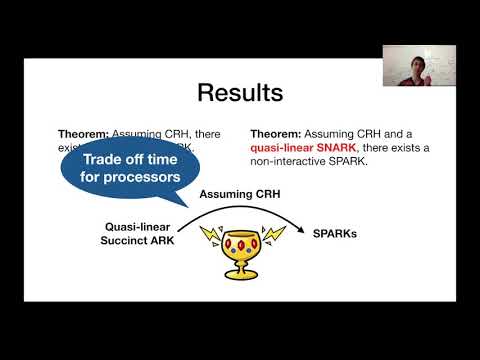Welcome to the resource topic for 2020/994
Title:
SPARKs: Succinct Parallelizable Arguments of Knowledge
Authors: Naomi Ephraim, Cody Freitag, Ilan Komargodski, Rafael Pass
Abstract:We introduce the notion of a Succinct Parallelizable Argument of Knowledge (SPARK). This is an argument of knowledge with the following three efficiency properties for computing and proving a (non-deterministic, polynomial time) parallel RAM computation that can be computed in parallel time T with at most p processors: (1) The prover’s (parallel) running time is T + polylog(T * p). (In other words, the prover’s running time is essentially T for large computation times!) (2) The prover uses at most p * polylog(T * p) processors, and (3) the communication and verifier complexity are both polylog(T * p). The combination of all three is desirable as it gives a way to leverage a moderate increase in parallelism in favor of near-optimal running time. We emphasize that even a factor two overhead in the prover’s parallel running time is not allowed. Our main contribution is a generic construction of SPARKs from any succinct argument of knowledge where the prover’s parallel running time is T * polylog(T * p) when using p processors, assuming collision-resistant hash functions. When suitably instantiating our construction, we achieve a four-round SPARK for any parallel RAM computation assuming only collision resistance. Additionally assuming the existence of a succinct non-interactive argument of knowledge (SNARK), we construct a non-interactive SPARK that also preserves the space complexity of the underlying computation up to polylog(T * p) factors. We also show the following applications of non-interactive SPARKs. First, they immediately imply delegation protocols with near optimal prover (parallel) running time. This, in turn, gives a way to construct verifiable delay functions (VDFs) from any sequential function. When the sequential function is also memory-hard, this yields the first construction of a memory-hard VDF.
ePrint: https://eprint.iacr.org/2020/994
Talk: https://www.youtube.com/watch?v=8w5r3-WhqDg
See all topics related to this paper.
Feel free to post resources that are related to this paper below.
Example resources include: implementations, explanation materials, talks, slides, links to previous discussions on other websites.
For more information, see the rules for Resource Topics .
